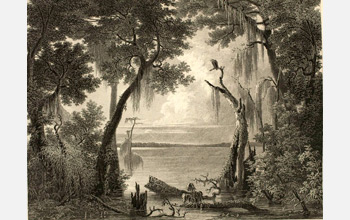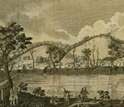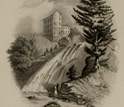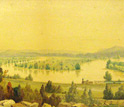News Release 10-226
America's Colonial Hydrologic History Recreated
Human activities played important role in the evolution of watersheds

"The Lake of the Dismal Swamp," by John Gadsby Chapman, 1842.
November 30, 2010
This material is available primarily for archival purposes. Telephone numbers or other contact information may be out of date; please see current contact information at media contacts.
Once lost in the mists of time, the colonial hydrology of the northeastern U.S. has been reconstructed by a team of geoscientists, biological scientists and social scientists.
The results, which extend as far back as the year 1600, appear in the current issue of the journal Environmental Science & Technology (ES&T).
The findings provide a new way of uncovering the hydrology of the past, and will lead to a better understanding of hydrologic systems now and in the future, the scientists say.
"We outline a methodology for synthesizing modern scientific data with historical records, including anecdotal sources," says Christopher Pastore of the University of New Hampshire, the paper's lead author. "It underscores the role of humans in an assessment of hydrologic change."
Throughout American history, water resources have played an integral role in shaping patterns of human settlement and networks of biological and economic exchange.
"The research emphasizes the effect of human activities on the evolution of watersheds and on the dynamics of ecosystems important to water sustainability," says Thomas Torgersen, program director in NSF's Division of Earth Sciences, which funded the research.
The scientists divided their study area into three geographic and socio-political subregions: New England; the Middle Colonies; and the Chesapeake.
They then looked at the ways in which physical variables--such as soil, vegetation, and climate--combined with socio-political factors to influence each subregion's hydrologic environment.
In New England, for example, close-knit religious communities with strong central governments concentrated their economic efforts on fur-trading and timber extraction, according to the paper's co-authors, which include Charles Vorosmarty of the City University of New York, principal investigator on the NSF grant.
The Chesapeake region, on the other hand, was settled largely by young, unskilled men who cleared trees and planted tobacco fencerow to fencerow. "This caused extensive erosion, which dramatically altered rivers," says Pastore.
The Middle Colonies were characterized by diverse social, cultural, and religious traditions and feudal-style estate agriculture.
Integration of human decision-making into analyses of land-cover change, engineering and climate change is fundamental to understanding subregional hydrologic patterns and how they interact, the scientists say.
They recommend two metrics for quantifying hydrologic change.
The first, which they call a simple water balance, takes into account precipitation, evapotranspiration, and water storage, which can be used to track changes in annual river discharge.
The second, termed mean water residence time, or the average time a water molecule spends in one place, can also be used to calculate the amount of water moving through a system.
The resulting information helps determine past water residence times, which in turn allow scientists to infer changes in the biogeochemistry of rivers and streams.
Many pathogens, or disease-causing organisms, are linked to water flows. An understanding of historical water residence times, says Pastore, may lead to new insights into how diseases are transmitted today.
Other co-authors of the paper are: Mark Green of Plymouth State University; Daniel Bain of the University of Pittsburgh; Andrea Munoz-Hernandez of the City University of New York; Jennifer Arrigo of East Carolina University; Sara Brandt of the U.S. Geological Survey in Northborough, Mass.; Jonathan Duncan of the University of North Carolina at Chapel Hill; Francesca Greco of King's College, London; Hyojin Kim of the University of California at Berkeley; Sanjiv Kumar of Purdue University; Michael Lally of the University of Massachusetts at Amherst; Anthony Parolari of MIT; Brian Pellerin of the U.S. Geological Survey in Sacramento, Calif.; Nira Salant of Utah State University; Adam Schlosser of MIT; and Kate Zalzal of the University of Colorado at Boulder.
-NSF-
-
Map showing the region of study broken down into socio-cultural subregions.
Credit and Larger Version -
"View of the West Bank of the Hudson's River 3 Miles above Still Water," 1789.
Credit and Larger Version -
"Red Mill Fall (Opposite Albany)" by William Tolman Carlton, 1847-1849.
Credit and Larger Version -
"The American Beaver," by John James Audubon, in: The Quadrupeds of North America, 1854.
Credit and Larger Version -
"View of the Oxbow," by Henry Woodward, 1859.
Credit and Larger Version
Media Contacts
Cheryl Dybas, NSF, (703) 292-7734, email: cdybas@nsf.gov
The U.S. National Science Foundation propels the nation forward by advancing fundamental research in all fields of science and engineering. NSF supports research and people by providing facilities, instruments and funding to support their ingenuity and sustain the U.S. as a global leader in research and innovation. With a fiscal year 2023 budget of $9.5 billion, NSF funds reach all 50 states through grants to nearly 2,000 colleges, universities and institutions. Each year, NSF receives more than 40,000 competitive proposals and makes about 11,000 new awards. Those awards include support for cooperative research with industry, Arctic and Antarctic research and operations, and U.S. participation in international scientific efforts.
Connect with us online
NSF website: nsf.gov
NSF News: nsf.gov/news
For News Media: nsf.gov/news/newsroom
Statistics: nsf.gov/statistics/
Awards database: nsf.gov/awardsearch/
Follow us on social
Twitter: twitter.com/NSF
Facebook: facebook.com/US.NSF
Instagram: instagram.com/nsfgov





